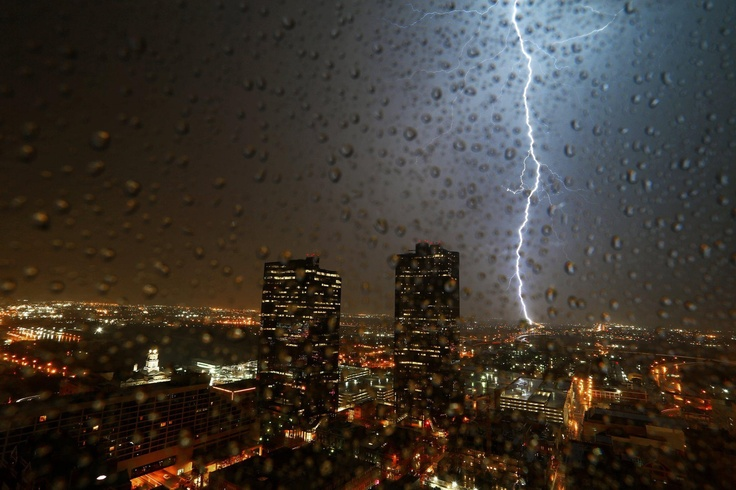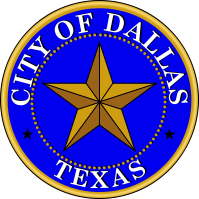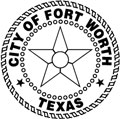Dallas–Fort Worth metroplex: Difference between revisions
| (26 intermediate revisions by the same user not shown) | |||
| Line 1: | Line 1: | ||
; '''[[ | ; '''[[New Republic of Texas]]''' | ||
== '''Quote''' == | == '''Quote''' == | ||
'''''Go Big - or - Go Home.''''' | |||
== '''Appearance''' == | == '''Appearance''' == | ||
[[File:Dallas Fort Worth by Night1.png]] | |||
== '''City | == '''City Devices''' == | ||
[[File:Seal Dallas Texas.png]],[[File:Seal Fort Worth Texas.png]]<br> | |||
== '''Climate''' == | == '''Climate''' == | ||
[[File:Dallas Fort Worth thunderstorm.png]] | |||
<br> | |||
<br> | |||
The Dallas-Fort Worth metroplex has a humid subtropical climate, though it is located in a region that also tends to receive warm, dry winds from the north and west in the summer, bringing temperatures to the 100 °F (38 °C) mark about 20 days annually, the majority in August, and heat indices easily breaking 110 °F (43 °C). When only temperature itself is accounted for, the north central Texas region where Dallas is located is one of the hottest in the United States during the summer months, usually trailing only the Mojave Desert basin of Arizona, southern Nevada, and southeastern California. Its temperature ranges are rather similar to those of Seville in Spain. | |||
Winters in the Dallas-Fort Worth metroplex are generally mild to warm, with a normal daily average temperature in January of 47.0 °F (8.3 °C) with sharp swings in temperature as strong cold fronts known as "Blue Northers" pass through the Dallas region, forcing daytime highs below the 50 °F (10 °C) mark for several days at a time and often between days with high temperatures above 80 °F (27 °C). Snow accumulation is seen in the city in about 70% of winter seasons, and snowfall generally occurs 1–2 days out of the year for a seasonal average of 1.5 inches (3.8 cm). Some areas in the region, however, receive more than that, while other areas receive negligible snowfall or none at all. | |||
A couple of times each winter in Dallas, warm and humid air from the south will override cold, dry air, resulting in freezing rain or ice and causing disruptions in the city if the roads and highways become slick. Temperatures reaching 70 °F (21 °C) on average occur on at least 4 days each winter month. Dallas-Fort Worth metroplex averages 26 annual nights at or below freezing, with the winter of 1999–2000 holding the all-time record as having the fewest freezing nights, with 14. During this same span of 15 years, the temperature in the region has only twice dropped below 15 °F (−9 °C), though it will generally fall below 20 °F (−7 °C) in most (67%) years. In sum, extremes and variations in winter weather are more readily seen in Dallas-Fort Worth and Texas as a whole than along the Pacific and Atlantic coasts, due to the state's location in the interior of the North American continent. The lack of any mountainous terrain to the north leaves it open to the sweep of Arctic weather systems. | |||
Spring and autumn bring pleasant weather to the area. Vibrant wildflowers (such as the bluebonnet, Indian paintbrush and other flora) bloom in spring and are planted around the highways throughout Texas. Springtime weather can be quite volatile, but temperatures themselves are mild. The weather in Dallas-Fort Worth is also generally pleasant from late September to early December and on many winter days. Autumn often brings more storms and tornado threat, but usually fewer and less severe than in spring. | |||
Each spring, cold fronts moving south from the North will collide with warm, humid air streaming in from the Gulf Coast, leading to severe thunderstorms with lightning, torrents of rain, hail, and occasionally, tornadoes. Over time, tornadoes have probably been the biggest natural threat to the city, as it is located near the heart of Tornado Alley. | |||
The former U.S. Department of Agriculture placed Dallas-Fort Worth in Plant Hardiness Zone 8a. However, mild winter temperatures in the past 15 to 20 years have encouraged the horticulture of some cold-sensitive plants such as Washingtonia filifera and Washingtonia robusta palms. According to the former American Lung Association, Dallas had the 12th highest air pollution among U.S. cities, ranking it behind Los Angeles and Houston. Much of the air pollution in Dallas and the surrounding area comes from a hazardous materials incineration plant in the small town of Midlothian and from concrete installations in neighbouring Ellis County. | |||
The all-time record low temperature within the city itself is −3 °F (−19 °C), set on January 18, 1930, while the all-time record high is 113 °F (45 °C), set on June 26 and 27, 1980 during the Heat Wave of 1980 at nearby Dallas–Fort Worth Airport. The average daily low in Dallas is 57.4 °F (14.1 °C) and the average daily high is 76.9 °F (24.9 °C). Dallas receives approximately 37.6 inches (955 mm) of rain per year. | |||
== '''Economy''' == | == '''Economy''' == | ||
| Line 35: | Line 54: | ||
== '''Current Events''' == | == '''Current Events''' == | ||
== '''Districts''' == | |||
* -- [[Telecom Corridor]] - {Richardson, DFW} | |||
== '''Fortifications''' == | == '''Fortifications''' == | ||
| Line 45: | Line 67: | ||
== '''Hotels & Hostels''' == | == '''Hotels & Hostels''' == | ||
* -- [[Magnolia Hotel of Dallas]] - <span style="color:#800000;">{Lair of the Red Pegasus Coven} | |||
== '''Landmarks''' == | == '''Landmarks''' == | ||
* -- [[Texas School Book Depository]] {Location of the 1963 assassination of President John F. Kennedy} | |||
== '''Maps''' == | == '''Maps''' == | ||
| Line 75: | Line 99: | ||
== '''Transportation''' == | == '''Transportation''' == | ||
* -- [[Dallas-Fort Worth International Airport]] -- Dallas-Fort Worth International Airport is centrally located within the Dallas–Fort Worth metroplex, and is the busiest airport in the New Republic of Texas. In terms of aircraft movements, it is the third busiest airport in the world. In terms of passenger traffic, it is the sixth busiest airport in the world transporting 105,789,531 passengers in 2031. In terms of land area, at nearly 18,000 acres, it is the largest airport in the New Republic of Texas, the second largest in the North America, and fourth largest in the world with a ground area larger than the island of Manhattan. The airport has long held the title of "The Best Cargo Airport in the World" according to the twenty-eighth edition of a survey. | |||
== <span style="color:#800000;">'''Sabbat of the Dallas-Fort Worth metroplex''' == | == <span style="color:#800000;">'''Sabbat of the Dallas-Fort Worth metroplex''' == | ||
* <span style="color:#800000;"> -- [[Archbishop Secundus]] -- Tremere ''antitribu'' leader of Dallas. | * <span style="color:#800000;"> -- [[Archbishop Secundus]] -- Tremere ''antitribu'' leader of Dallas. | ||
* <span style="color:#800000;"> -- [[Angelo]] -- | |||
=== <span style="color:#800000;">'''Sabbat Packs of DFW''' === | |||
* <span style="color:#800000;"> -- '''[[Grigori]]''' -- The Archbishop's Coven. | |||
* <span style="color:#800000;"> -- '''[[Band of Brothers]]''' -- The largest known pack of Blood-Brothers in the World. {led by [[Angelo]]} | |||
* <span style="color:#800000;"> -- '''[[Los Caballeros]]''' -- A coven of elitist bloodlines including: Lasombra, Tzimisce, Ventrue and Toreador ''antitribu''. {Conservative Faction} | |||
* <span style="color:#800000;"> -- '''[[Ordo Templariorum Occidentis]]''' -- The selective coven of Tremere ''antitribu'' who mystically protect the DFW. | |||
* <span style="color:#800000;"> -- '''[[Shadow Legion]]''' -- An all Lasombra pack known for its strict discipline and military tactics. {Sword of Caine} | |||
* <span style="color:#800000;"> -- '''[[Red Pegasus]]''' -- An sybaritic Albigensian coven that holds court in the Magnolia Hotel. {Unaligned} | |||
== '''Websites''' == | == '''Websites''' == | ||
http://en.wikipedia.org/wiki/Dallas%E2%80%93Fort_Worth_metroplex | |||
http://www.mappery.com/Dallas-Fort-Worth-Map-2 | http://www.mappery.com/Dallas-Fort-Worth-Map-2 | ||
http://www.jamesedition.com/stories/real-estate/dallas-new-dazzle-luxury-homes-draw-buyers-to-texas-1561 | |||
Latest revision as of 16:23, 4 June 2014
Quote
Go Big - or - Go Home.
Appearance
City Devices
Climate

The Dallas-Fort Worth metroplex has a humid subtropical climate, though it is located in a region that also tends to receive warm, dry winds from the north and west in the summer, bringing temperatures to the 100 °F (38 °C) mark about 20 days annually, the majority in August, and heat indices easily breaking 110 °F (43 °C). When only temperature itself is accounted for, the north central Texas region where Dallas is located is one of the hottest in the United States during the summer months, usually trailing only the Mojave Desert basin of Arizona, southern Nevada, and southeastern California. Its temperature ranges are rather similar to those of Seville in Spain.
Winters in the Dallas-Fort Worth metroplex are generally mild to warm, with a normal daily average temperature in January of 47.0 °F (8.3 °C) with sharp swings in temperature as strong cold fronts known as "Blue Northers" pass through the Dallas region, forcing daytime highs below the 50 °F (10 °C) mark for several days at a time and often between days with high temperatures above 80 °F (27 °C). Snow accumulation is seen in the city in about 70% of winter seasons, and snowfall generally occurs 1–2 days out of the year for a seasonal average of 1.5 inches (3.8 cm). Some areas in the region, however, receive more than that, while other areas receive negligible snowfall or none at all.
A couple of times each winter in Dallas, warm and humid air from the south will override cold, dry air, resulting in freezing rain or ice and causing disruptions in the city if the roads and highways become slick. Temperatures reaching 70 °F (21 °C) on average occur on at least 4 days each winter month. Dallas-Fort Worth metroplex averages 26 annual nights at or below freezing, with the winter of 1999–2000 holding the all-time record as having the fewest freezing nights, with 14. During this same span of 15 years, the temperature in the region has only twice dropped below 15 °F (−9 °C), though it will generally fall below 20 °F (−7 °C) in most (67%) years. In sum, extremes and variations in winter weather are more readily seen in Dallas-Fort Worth and Texas as a whole than along the Pacific and Atlantic coasts, due to the state's location in the interior of the North American continent. The lack of any mountainous terrain to the north leaves it open to the sweep of Arctic weather systems.
Spring and autumn bring pleasant weather to the area. Vibrant wildflowers (such as the bluebonnet, Indian paintbrush and other flora) bloom in spring and are planted around the highways throughout Texas. Springtime weather can be quite volatile, but temperatures themselves are mild. The weather in Dallas-Fort Worth is also generally pleasant from late September to early December and on many winter days. Autumn often brings more storms and tornado threat, but usually fewer and less severe than in spring.
Each spring, cold fronts moving south from the North will collide with warm, humid air streaming in from the Gulf Coast, leading to severe thunderstorms with lightning, torrents of rain, hail, and occasionally, tornadoes. Over time, tornadoes have probably been the biggest natural threat to the city, as it is located near the heart of Tornado Alley.
The former U.S. Department of Agriculture placed Dallas-Fort Worth in Plant Hardiness Zone 8a. However, mild winter temperatures in the past 15 to 20 years have encouraged the horticulture of some cold-sensitive plants such as Washingtonia filifera and Washingtonia robusta palms. According to the former American Lung Association, Dallas had the 12th highest air pollution among U.S. cities, ranking it behind Los Angeles and Houston. Much of the air pollution in Dallas and the surrounding area comes from a hazardous materials incineration plant in the small town of Midlothian and from concrete installations in neighbouring Ellis County.
The all-time record low temperature within the city itself is −3 °F (−19 °C), set on January 18, 1930, while the all-time record high is 113 °F (45 °C), set on June 26 and 27, 1980 during the Heat Wave of 1980 at nearby Dallas–Fort Worth Airport. The average daily low in Dallas is 57.4 °F (14.1 °C) and the average daily high is 76.9 °F (24.9 °C). Dallas receives approximately 37.6 inches (955 mm) of rain per year.
Economy
Geography
History
Population
- -- City (1,241,162) - 2012 census
- -- Urban (5,121,892) - 2012 census
- -- Metro Area (6,700,991) - 2012 census
Arenas
Attractions
Bars and Clubs
Cemeteries
City Government
Crime
Citizens of the City
Current Events
Districts
- -- Telecom Corridor - {Richardson, DFW}
Fortifications
Galleries
Holy Ground
Hospitals
Hotels & Hostels
- -- Magnolia Hotel of Dallas - {Lair of the Red Pegasus Coven}
Landmarks
- -- Texas School Book Depository {Location of the 1963 assassination of President John F. Kennedy}
Maps
Market Places
Monasteries
Monuments
Museums
Neighborhoods
Parks
Private Residences
Restaurants
Ruins
Schools
Shops
Theaters
Transportation
- -- Dallas-Fort Worth International Airport -- Dallas-Fort Worth International Airport is centrally located within the Dallas–Fort Worth metroplex, and is the busiest airport in the New Republic of Texas. In terms of aircraft movements, it is the third busiest airport in the world. In terms of passenger traffic, it is the sixth busiest airport in the world transporting 105,789,531 passengers in 2031. In terms of land area, at nearly 18,000 acres, it is the largest airport in the New Republic of Texas, the second largest in the North America, and fourth largest in the world with a ground area larger than the island of Manhattan. The airport has long held the title of "The Best Cargo Airport in the World" according to the twenty-eighth edition of a survey.
Sabbat of the Dallas-Fort Worth metroplex
- -- Archbishop Secundus -- Tremere antitribu leader of Dallas.
Sabbat Packs of DFW
- -- Grigori -- The Archbishop's Coven.
- -- Band of Brothers -- The largest known pack of Blood-Brothers in the World. {led by Angelo}
- -- Los Caballeros -- A coven of elitist bloodlines including: Lasombra, Tzimisce, Ventrue and Toreador antitribu. {Conservative Faction}
- -- Ordo Templariorum Occidentis -- The selective coven of Tremere antitribu who mystically protect the DFW.
- -- Shadow Legion -- An all Lasombra pack known for its strict discipline and military tactics. {Sword of Caine}
- -- Red Pegasus -- An sybaritic Albigensian coven that holds court in the Magnolia Hotel. {Unaligned}
Websites
http://en.wikipedia.org/wiki/Dallas%E2%80%93Fort_Worth_metroplex


